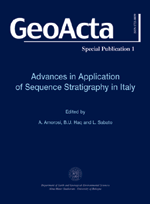Abstract
Stratigraphic investigations of late Quaternary deposits commonly suffer from poor-quality data available from wells and geotechnical boreholes drilled beneath the modern alluvial, deltaic and coastal plains. This study shows how accurate facies identification from continuous cores may allow a considerably finer stratigraphic resolution, which can be readily used for high-resolution sequence stratigraphic interpretation, three-dimensional reconstruction of sedimentary bodies, and thus for aquifer management. This paper describes, in general terms, the sedimentological characteristics of late Quaternary deposits from a variety of Po Plain cores, and summarizes the major facies associations that were formed during the last glacial/ interglacial cycle. Sediment colour, grain size, thickness, facies boundaries, sedimentary structures, and accessory material (fossil content, plant debris, roots, pedogenic features) are discussed as fundamental facies discriminators and supportive evidence for specific depositional environments. Where evaluation of individual facies is difficult, the stacking patterns of facies may contribute important information about depositional environments and sequence-stratigraphic interpretation of late Quaternary deposits. In particular, identification of deepening-upward versus shallowing-upward trends enables the distinction between transgressive and highstand sedimentation, respectively. Finally, it is shown how simple, in situ geotechnical measurements (i.e., pocket penetrometer data) can provide additional information for reliable facies interpretations. Reading geology from cores is a matter of practice: some facies attributions are straightforward, but others are ambiguous. Although cores only provide a thin cylinder of sediment to study, a stratigraphic approach based upon identification of vertical facies sequences and facies tracts can help significantly in reconstructing highresolution subsurface stratigraphy of late Quaternary deposits.
Keywords: Core analysis, Facies interpretation, Stratigraphy, Po Plain, late Quaternary


